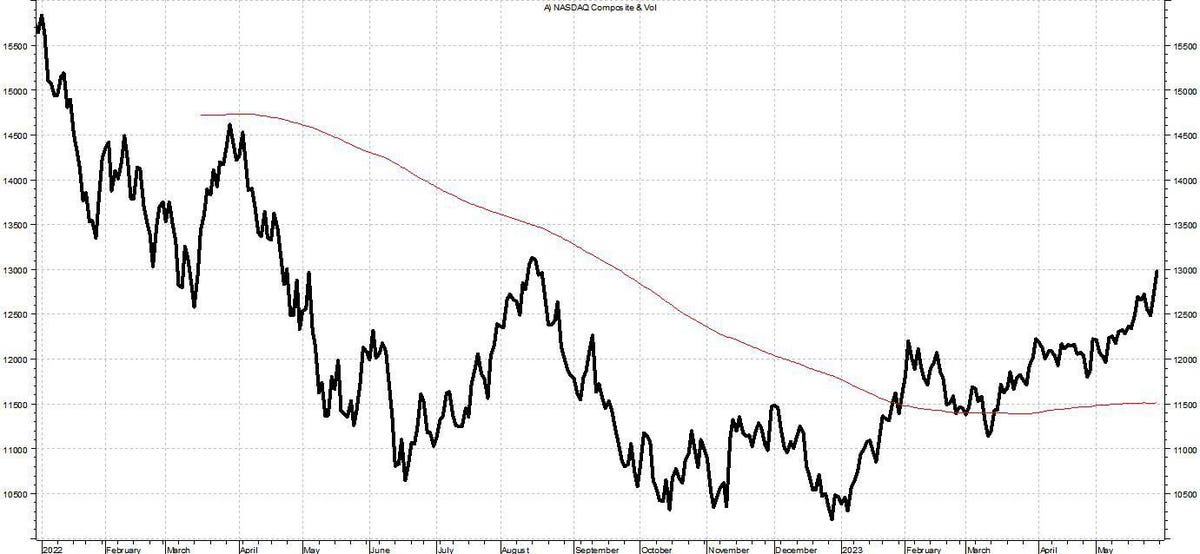Market divergences can lead investors to chase high flying stocks at a peak.
As we wrap up May, we find that key market indices are moving in opposite directions. While the NASDAQ Composite has made up much of its loss from 2022, many large segments of the U.S. stock market represented by benchmarks like the Dow Jones Industrial Average, NYSE Composite, S&P 400 Midcap Index, Russell 2000 Small Cap Index are actually at losses for 2023. This market anomaly is called, “index divergence.”
ADVERTISEMENT
It’s feeling a bit like 1999, I’m hearing the same emotional calls by investors to only focus on “New Era” investments (AI, ESG, Bitcoin
BTC
Investors have long relied on the Dow Jones Industrial Average and S&P 500 Index, believing them to be unbiased, accurate gauges of the overall stock market. Their trust was well earned by the father of the stock market average, Charles Dow. His ground-breaking research in the late 1800’s proved that a well-constructed index could be an invaluable tool for investors to evaluate the current financial conditions and compare the market’s recent performance to the past.
ADVERTISEMENT
However, when these trusted market benchmarks became popular investment products, they were placed in the hands of Wall Street’s marketing machine. It operates on the maxim, “Sizzle Sells Securities.” This might explain why the S&P 500 Index includes both shares of Google
GOOG
The ABC’s of modern stock market indices:
Investors would be wise to better understand the facts & fallacies of modern financial statistics.
1. Different Calculations Produce Various Results –
It is difficult to make a representative index of the total stock market, because each methodology has advantages & weaknesses.
ADVERTISEMENT
The Dow Jones Industrial Average is price-weighted by buying 100 shares in each stock and effectively gives a higher weight to pricier stocks. This means that, in terms of percentage change Goldman Sachs, with a price of $331, is much more important than Intel
INTC
The S&P 500 Index, on the other hand, is market cap weighted. This means the “big name” stocks have a higher weighting than poor performing equities. It also tends to exacerbate the influence of “hot” sectors and companies. During the tech bubble of the 1990s, it skewed toward tech; During the mortgage bubble in 2008, it favored financial companies.
Today, approximately 50 companies comprise nearly 50% of its market capitalization. If you buy an S&P 500 index fund today, you own twice as much Apple
AAPL
ADVERTISEMENT
It’s easy to see the performance “mirage” of today’s current environment by looking at the current S&P 500 with both weighted and unweight calculations. Very different performance results with the same exact group of companies over the same timeframe!
ADVERTISEMENT
Ironically, neither index truly represents how most investors manage their portfolios, and its opposite of the Wall Street doctrine of “Diversify & Rebalance”.
2. Index Components are Always Changing –
Since the 1980’s, we’ve seen the introduction of all kinds of financial products based on the passive investing theme, including exchange-traded index funds (ETFs).
However, passive index investing doesn’t mean static and has had an influence on inclusion and exclusion of stocks into major market benchmarks based on popularity. Of the 500 components of the S&P 500 in 1999, less than 41% were still in the index at the end of 2021. This high level of turnover might be expected in an index of small stocks or foreign stock markets, but this index is supposed to represent larger companies with long histories. Obviously, if a company goes bankrupt, is acquired, or otherwise fails to meet inclusion criteria, it must be removed from the index. But, what about the 64 companies that were removed from the index in the period I studied that are still in business?
ADVERTISEMENT
Consistency is important for historical comparisons. These stocks are ideal, because they have been publicly traded for a long time and generate billions of dollars in revenue. Sure, their stock-price performance has been poor overall. So? That mirrors the performance of many other publicly traded stocks in the market. Simply put, a consistent market benchmark should include the “good, bad & ugly” of the entire stock market universe — not just Wall Street’s current darlings.
What Should Investors Do?
· Follow multiple benchmarks to determine overall market strength & trends.
· Study other market statistics to determine market health (NYSE & NASDAQ Advance Decline studies)
· Watch other markets for clues (bonds, commodities, foreign stocks)
ADVERTISEMENT
· Pay attention to market seasonality – stock investing in the summertime can be very volatile.
· Don’t be afraid to trim back on highflying stocks.
It’s not different this time!
Although this market condition is unusual, it happened before and warrants caution.
Before investors commit to new money because a handful of tech stocks are driving the S&P 500 higher, remember that divergences don’t last forever; at some point all the horses need to be pulling in the same direction.
ADVERTISEMENT
Read the full article here




